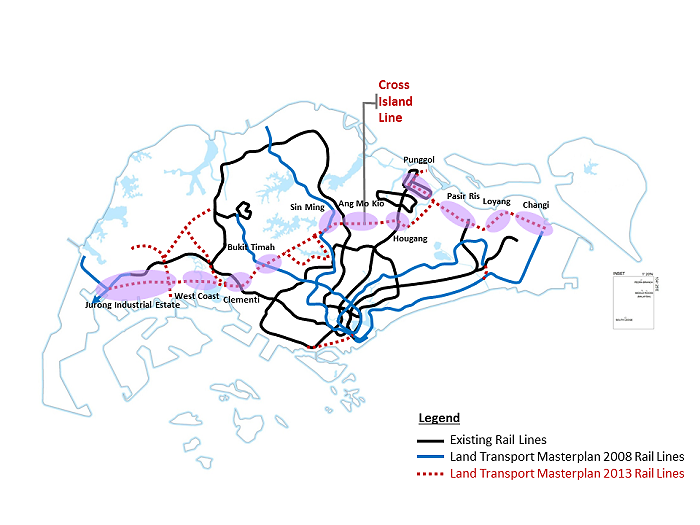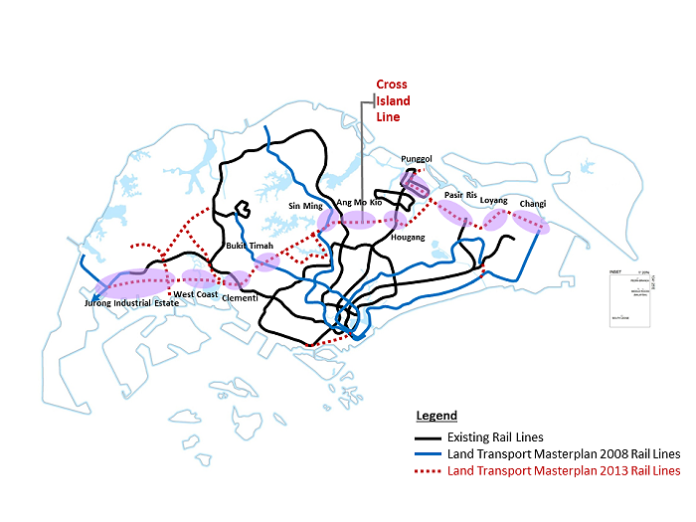SINGAPORE: The first phase of the Cross Island Line (CRL), Singapore’s eighth MRT line and its longest fully underground line, will open by 2029, Transport Minister Khaw Boon Wan said on Friday (Jan 25).
Speaking during a visit to the work site of Bright Hill MRT station on the Thomson-East Coast Line, Mr Khaw confirmed that the CRL’s first phase will have 12 stations, in areas such as Changi, Loyang, Pasir Ris, Hougang and Ang Mo Kio.
First announced as part of the Transport Master Plan 2013, the CRL will stretch across Singapore to connect the western, north-eastern and eastern parts, including “potentially Changi Airport”, Mr Khaw said.
Bright Hill will be one of four interchange stations in phase one of the CRL. The other interchange stations will be at Ang Mo Kio with the North-South Line, Hougang with the North East Line and at Pasir Ris with the East-West Line.

Map showing the Cross Island Line route. (Map: LTA)
With the opening of the first phase, more than 10,000 households along the 29-km stretch will have their travelling times reduced, he said. It will also bring Singapore closer to its goal of having eight in 10 households living within a 10-minute walk of an MRT station.
“It will help realise our vision for a ‘car-lite’ Singapore,” he said.
Mr Khaw added that the line will support new hubs of economic activity outside the central business district, such as the Jurong Lake District, Punggol Digital District and Changi region.
“Recreational spaces such as Changi Beach Park and the nearby Bishan-Ang Mo Kio Park will also become more accessible to Singaporeans using public transport,” he said.
CRL TO RELIEVE PASSENGER LOADS ON OTHER LINES
The CRL will also help to relieve passenger loads on the North-South Line, East-West Line and the North-East Line, Mr Khaw said.
“With the CRL stations interchanging with all existing radial lines, commuters will have more journey options to get to their destinations. Many will benefit from shorter journeys and faster travel times,” he said.
For example, commuters travelling from Serangoon North to the Loyang industrial area using the CRL will see their journey times reduced by 50 minutes, he pointed out.
ONE SIGNALLING SYSTEM, BETTER COMPONENTS
Recalling various local and overseas examples of train disruptions due to different signalling systems, the minister said that the CRL will only have one signalling system.
“We have also learnt that the signalling system comes with a lot of vehicle on-board controllers and trackside equipment. If such devices or components come from less than reliable manufacturers or are not robust enough to withstand the vibrations of a moving train, then the final signalling system delivered to us will have lots of cleaning up or replacement problems during operation,” said Mr Khaw.
The construction of the first phase of the CRL starts in 2020, and he warned that “there will be some impact to nearby residents and businesses”.
“LTA will work closely with its contractors and the local community to minimise these inconveniences,” said Mr Khaw.
A new MRT depot, the CRL Changi East depot, will be opened. The depot was originally planned as an underground facility, like the rest of the CRL stations and tunnels, but authorities decided to locate it and its reception tracks above ground after a “thorough cost-benefit analysis”.
“The decision will save taxpayers more than S$3.5 billion,” said Mr Khaw.
The Land Transport Authority has also started calling tenders for the construction of Singapore’s seventh MRT line, the Jurong Region Line.





